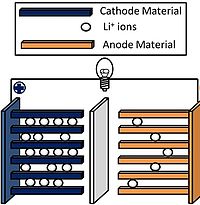
Photo from wikipedia
Cobalt Oxide (Co3O4) was reduced to metallic Co using the nut shells of pistachio by heat treatment at temperatures of 1400°C and 1500°C in an argon gas atmosphere. This method… Click to show full abstract
Cobalt Oxide (Co3O4) was reduced to metallic Co using the nut shells of pistachio by heat treatment at temperatures of 1400°C and 1500°C in an argon gas atmosphere. This method for reducing Cobalt Oxide may provide a valuable route for reclaiming nanoparticles of metallic Co from waste material. Rietveld analysis of the x-ray diffraction profiles showed the presence of two phases of Co; FCC (γ-Co), and ΒCC phase of Co in addition to the presence of C in the graphite phase. The samples synthesized by processing at 1400°C showed only the FCC phase of Co whereas mixed phases of FCC and BCC Co were formed for samples heat treated at 1500°C. The magnetic properties were determined using VSM and FMR measurements. A magnetic saturation value of 160 emu/g was determined for the FCC phase which is consistent with the literature value. On the other hand, the magnetic saturation value of BCC Co was measured to be 214 emu/g. Magnetic data suggest the average magnetic moment is consistent with FCC cobalt. This simple method of producing BCC-Co has potential industrial and possible medical applications such as magnetic sensors, electromagnetic shielding, magnetic memory, magnetic fluids, magnetic composites and catalysis.
Journal Title: Journal of Electronic Materials
Year Published: 2019
Link to full text (if available)
Share on Social Media: Sign Up to like & get
recommendations!